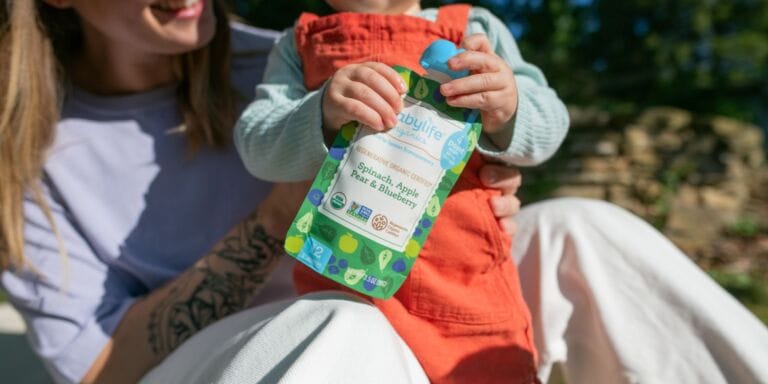11-month-old baby health & growth guide

Anna Kraynova/Shutterstock
Your growing 11-month-old is finding their footing (literally).
We independently select and share the products we love—and may receive a commission if you choose to buy.
Table of Contents
Your little one may suddenly not seem so little—that big first birthday is just around the corner! Every day, your growing 11-month-old is finding their footing (literally) and making major strides in their development. They’re lucky to have you as a cheerleader, seeing them through every step of the way. We’re hopeful that all these big moves are tiring them out at night, meaning more sleep for everyone. We have more helpful sleep tips below, along with everything else you need to know about your baby’s health and growth this month.
Related: 11-month-old baby milestones
11-month-old baby nutrition
Showing more interest in foods is something to look out for at 11 months, as solids start to become more of a staple part of your baby’s diet.
Your tot is hopefully discovering a few favorites and possibly even feeding themselves at this stage. Keep offering a spoon sized for small hands and a sippy cup with water at meals, and work on presenting as many new foods as possible. Star fruit, anyone?
At 11 months, your baby is within the window where they’re very open to new tastes and textures—and it’ll pay off majorly now to capitalize on that openness before the much more “independent” toddler years. You might be able to offer them more family meals now that they’re a bit older—a few bites of what everyone’s eating will help them feel like part of the action and hopefully encourage them to keep trying new flavors. Just be sure to watch the salt—babies under 1 can’t process large amounts of sodium or salt just yet.
The AAP and La Leche League (LLL) recommend the following feeding timeline and amounts for 11-month-olds:
- Solids: Offered 3 times per day or at family mealtimes
- Breast milk: Up to 8 ounces every 4 to 5 hours
- Formula: 7 to 8 ounces every 5 to 6 hours
Your 11-month-old should be no stranger to solids. Here are the recommended serving sizes for an 11-month-old baby:
- Infant cereal (single grain) mixed with breast milk or formula: 5 to 8 tablespoons (optional)
- Fruits: 2 to 4 tablespoons
- Vegetables: 2 to 4 tablespoons
- Shredded meats, eggs, yogurt and soft-cooked plant-based proteins, such as lentils: 2 to 3 tablespoons
- Starches: ¼ to ½ cup simple carbs, such as pasta, mashed potatoes, bread
Early exposure to foods that fit in the top 8 categories of potential allergens (dairy, eggs, peanuts, tree nuts, fish, shellfish, wheat, sesame and soy) should also be incorporated, unless you’ve already identified an allergy or sensitivity with your child’s pediatrician. They can provide more guidance on the matter.
Related: Yes, it’s normal if your baby doesn’t crawl
11-month-old baby weight
For babies up to 2 years of age, the Centers for Disease Control and Prevention (CDC) recommend using the World Health Organization (WHO) weight and length charts.
The WHO growth charts for babies 0 to 2 years are based on what is standard for a predominantly breastfed infant. According to the organization, the WHO charts reflect growth patterns among children who were predominantly breastfed for at least 4 months and were still breastfeeding at 12 months. The American Academy of Pediatrics (AAP) recommends continuing to breastfeed for at least two years, as long as it benefits both mother and baby.
How much does the average 11-month-old weigh?
By their first birthday, generally speaking, your baby should have tripled their birth weight. Though their weight gain rate has slowed down as compared to their first six months of life, they should still gain a few ounces this month.
According to the WHO and CDC:
- A 11-month-old baby boy in the 50th percentile weighs 20 pounds 12 ounces (9.4 kilograms)
- A 11-month-old baby girl in the 50th percentile weighs 19 pounds, 4 ounces (8.7 kilograms)
What factors contribute to a 11-month-old baby’s weight?
Your baby’s weight may be a factor of how much they’re eating, their assigned sex and their activity levels.
Assigned sex at birth: Male babies tend to weigh slightly more than female babies.
Daily food intake: The amount your baby takes in at each feeding may factor into their weight. Many babies are still breastfeeding or taking bottles of formula 4 to 6 times per day at 11 months.
Activity levels: Baby is working on standing up and cruising this month in preparation for walking. Physical activity helps build strong muscles and bones—which means their activity levels may factor into their overall weight.
Related: When will my baby start walking? Experts share there’s a wide range
11-month-old baby length
Growth has slowed down since your babe turned 6 months, but in month 11, you can expect your baby to grow about ½ inch to ¾ inch (1 to 2 centimeters) in length.
How long is the average 11-month-old?
According to the WHO and CDC:
- A 11-month-old baby boy in the 50th percentile is 29 ¼ inches long (74.5 cm)
- A 11-month-old baby girl in the 50th percentile is 28 ½ inches long (72.8 cm)
What factors contribute to a 11-month-old baby’s length?
Your baby’s future height may be mostly predetermined by genetics (babies tend to resemble their parents in height), but their length each month can also be related to other factors, including physical activity, nutrition, sleep and overall health. And those gross motor skills they’re working on lately helps contribute to strong bones and muscles, too.
Related: Activities for an 11-month-old: Fostering baby’s development
Growth charts and percentiles
Your child’s pediatrician has been plotting their weight, length and head circumference on their growth chart at each well-check, and monitoring your child’s growth curve to see how their growth has been changing over time. Growth charts and percentiles can also be helpful in providing an example of how a baby’s growth may be compared to that of other babies who are the same age and sex, but try not to get too focused on the comparisons, here. All babies grow at different rates.
Did you get current height and weight percentiles at your baby’s 9-month well-check? Here’s how to interpret those numbers: Let’s say your baby’s weight is in the 60th percentile. That means that 40% of babies of the same age and sex weigh more, and 60% weigh less. But know that healthy babies can be in the 5th percentile or the 95th, AAP says. Doctors are just looking at whether your child’s growth pattern stays somewhat steady.


Growth spurts
The next growth spurt, or period of rapid growth, you might see is closer to the 12-month mark. Of course, every baby is different, so it could happen earlier—or later. If you’re noticing that your tot is more fussy than usual, going through some sleep changes (more night waking) or is especially hungry, a growth spurt could be to blame (or perhaps teething!).
Generally speaking, most growth spurts only last a couple of days, but they could have repercussions for up to a week. But don’t worry, they’ll soon pass—and they’re a good sign of your baby’s healthy development.
When should I worry about my baby’s growth?
Remember that your child’s doctor has been using their growth chart to help track along with your child’s growth, and if they’re worried about your 11-month-old’s growth, they’ll definitely let you know.
By 11 months, some parents are concerned about when their child will start to walk. But rest assured that experts say there’s a wide range of normal when it comes to walking. As long as your little one is able to bear weight on their legs, and shows interest in moving around (many will start grabbing onto furniture to help them get from one place to another, known as ‘cruising’), trust that as they get stronger, those first steps will come.
Feeding, sleep and diaper output are all signs of your baby’s growth, too. If you have concerns about your baby’s feeding or sleeping habits, or if they’re not approaching most of their 11-month milestones, check in with the doctor.
11-month-old baby sleep
Babies under 12 months still need 12 to 16 hours of sleep per 24 hours, the American Academy of Sleep Medicine states. You can probably anticipate your baby needing at least somewhere between 12 to 13 hours of sleep between night sleep and naps combined. Aim for a minimum of 10 hours nightly at the very least, plus two naps during the day.
Given that your baby is working on so many developmental milestones this month, from walking prep to increased communication and stronger interest in foods, we’re betting (hoping!) your tot might be tuckered out at night. But if they somehow seem to get a second wind post-dinner, consider trying to get more outdoor time into their schedule. Going for a walk or running around the backyard can help to balance energy and circadian rhythms.
What baby sleep looks like at 11 months:
- Your baby may be taking 2 naps per day
- Your baby may no longer be waking at night
- Your baby may be awake for 2.5 to 3.5 hours at a time
Read more: How much sleep does an 11-month-old baby need?
Sleep training
If you haven’t attempted sleep training yet, which involves helping your baby self-soothe back to sleep on their own after waking at night, now might be the time to start.
According to Rachel Mitchell, certified sleep consultant and founder of My Sweet Sleeper, there are two ways you can determine if your child is ready for some level of sleep training:
1. You’re ready and have time to commit to the process
2. You have laid a healthy foundation of sleep with your baby
“Without first establishing healthy habits with your baby, sleep training is typically ineffective or may not withstand future regressions and/or developmental leaps,” Mitchell writes.
Once you decide to move forward, you’ll likely want to do some research to determine the right approach for your child, she notes.
From gentle sleep training to cry-it-out, there’s a wide range of options. “I encourage you to focus on what you think is most realistic for your family and not to compare your baby to anyone else’s child or experience.” Mitchell recommends taking a quick quiz to determine your baby’s sleep profile first. Ask your child’s pediatrician for supportive tips, too.
Related: Gentle sleep training doesn’t have to be miserable
Diapering an 11-month-old
You’re likely still going through anywhere from 5 to 7 diapers a day with your 11-month-old, and seeing at least one poop per day. That said, some will likely poop every other day, and still others will poop three times a day. All can be normal—what counts here is the stool consistency. You’re looking for poop that is formed but not hard, and is in a color range of brown to green to yellow. If it’s pellet-like, especially hard or runny, it could be a sign of constipation or diarrhea, respectively. If you’re concerned, reach out to your child’s pediatrician.
Caring for an 11-month-old
Here’s what to know about baths, safety and care for your growing babe.
Baths
At 11 months, your babe still only needs two to three baths per week at the max; a daily bath isn’t a necessity—they just don’t get that dirty on a daily basis! Of course, if a nightly bath is part of the bedtime routine that works for your family, just aim to keep those soaks on the shorter side to avoid contributing to dry skin.
Related: 14 bath safety tips for babies and kids of all ages
Water safety
With a decently mobile 11-month-old, even common household items you wouldn’t think could be dangerous suddenly prove problematic, like toilets and pools. Water safety is especially important at this age when your tot is curious about everything around them, and even an inch of water can be a drowning risk. It’s distressing but true: Drowning remains the number one cause of unintentional injury-related death among children ages 1 to 4, taking the lives of three children in the United States every day. Here are a few tips to keep in mind.
Water safety for babies and toddlers
- Keep toilet lids and/or bathroom doors closed or fitted with a child-proof lock when not in use
- Keep pool gates closed and possibly fitted with an alarm or locking system
- Avoid leaving your child unattended in the bath
- Avoid walking away from the bathtub while filling it
- Swap out floaties and puddle jumpers for U.S. Coastguard-Approved Lifejackets when swimming
- Designate a water guardian when swimming
- Suit up your little one in brightly colored swimsuits only, which are easier to spot underwater
Related: 5 water safety tips to share with all your kids’ caregivers this summer
Guidelines on screentime for babies
Sometimes it feels like turning on “Daniel Tiger” for your tot is the only way to actually get anything done—we absolutely get it. But in order to set up and model healthy screen time and media habits for your little one, AAP discourages the use of screens for babies under 18 months, unless it’s video chatting with a friend or family member. (Calling Grandma to FaceTime with your toddler while you hurriedly prep dinner? Been there.) Of course, things pop up, and sometimes handing over your phone is the simplest way to keep the peace on a long flight or at a restaurant, say. The goal? Just be mindful about both quality and quantity. Once your mini turns 18 months, you can start to incorporate high-quality shows and apps, watching or using them together with your child. But still aim for less than 1 hour per day when you can. (That goes for toddlers and preschool-age kiddos, too.)
Related: Most kids under 5 getting too much screen time, study finds
A note from Motherly on self-care while caring for a 11-month-old
We’re betting life feels busy these days, what with all the chasing after your increasingly more mobile baby and keeping them (safely) entertained. But don’t skimp on carving out time for the things that keep you well and feeling good, too. If you need a reminder to make that doctor’s appointment or call that therapist or set a date with a friend you haven’t seen in ages, this is your sign. Moms often put their own health on the back burner, but let’s try to break that cycle.
And if you feel like you’re struggling more than usual, remember that postpartum depression can set in anytime in the first year after birth—and resources are out there. Reach out to your primary care provider to talk about more mental health support, whether that’s medication, therapy or a combination.
Look ahead: 12-month-old baby health & growth guide
Postpartum mental health resources
If you’re experiencing any postpartum mood symptoms, no matter how mild, know that help is available. Reach out to your healthcare provider about next steps and potential treatment options, such as more support at home, therapy or medication. If you’re in crisis, reach out to a crisis hotline or dial 988 or 911 for immediate support.
The phone numbers listed below are available 24/7 to help you with suicidal thoughts or other mental health crises.
- The National Maternal Mental Health Hotline: 1-833-TLC-MAMA (1-833-852-6262)
- Available in English and Spanish and in a completely confidential line.
- Postpartum Support International: 1-800-944-4773 (call or text)
- Available in English and Spanish
- National Crisis Text Line: Text HOME to 741741
- National Suicide Prevention Hotline: Call or text 988
- Available in English and Spanish
A version of this story was originally published on April 8, 2023. It has been updated.




































